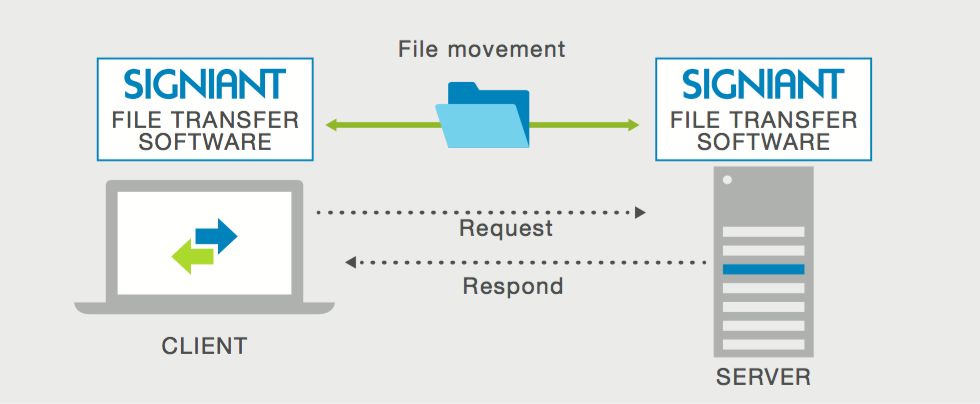Signiant’s Core Technology: The Powerful Platform Behind All of Our Products
All of Signiant’s Products Are Built on the Same Powerful Technology Platform.
Companies like Disney, Fox, the NFL, and many others rely on the Signiant Platform to securely move their files. The combined technological features of this platform focus on acceleration, reliability, security and scale-out management. Together they enable any size file of any type to be sent over any distance quickly, reliably and securely.
Acceleration
Signiant’s proprietary acceleration protocol transfers files up to 100x faster than standard TCP-based transmission. It does this by minimizing the impact of latency so that the entire bandwidth of the connection can be fully utilized. Signiant technology therefore has the greatest impact for a high-bandwidth, high-latency (long distance) connection — as shown in green in the figure below.
Another way of visualizing the performance improvement is to compare Signiant transfers with TCP transfers over various distances, and to then repeat this comparison for different bandwidth connections. As shown in the nest diagram, with TCP the file transfer takes proportionally longer as distance/latency increases and packet loss occurs. With Signiant, not only is the transfer time much shorter, it’s also independent of distance — and as more bandwidth is added the Signiant transfer time gets proportionally faster.
The Signiant Platform achieves this performance by utilizing a proprietary transport protocol deployed on top of UDP (User Datagram Protocol) that enhances it in significant ways. UDP enables chunks of data to be sent on a best-effort basis that removes the TCP overhead of back-and-forth handshaking between the two ends of the IP transmission path — but it does so by foregoing reliability. The Signiant protocol implements functionality on top of UDP that restores reliability in a TCP-like way, but with the following improvements:
➜ Flow control ensures that data is transmitted at the optimal rate for the receiver
➜ Congestion control detects when the network is being overloaded and adapts accordingly
➜ Reliability mechanisms make sure that data loss due to congestion or other network factors is compensated for and that the order of the stream of data is maintained
One fundamental problem with TCP is that it uses a relatively unsophisticated sliding window mechanism, sending only a certain amount of data over the network before it expects that data to be acknowledged as received. As TCP receives acknowledgments, it advances its window and sends more data. If the data doesn’t get through or an acknowledgment is lost, TCP will time out and retransmit from the last acknowledged point in the data stream with a reduced window size. There are a number of problems with this, such as retransmitting data that may have already been received, or long stalls in data sent while waiting on acknowledgments.
Signiant uses a mechanism similar to a sliding window, but the mechanism incorporates two key improvements over traditional TCP: adaptive window size and selective acknowledgment. Adaptive window size is a mechanism that measures the capacity of the network and the round trip distance. It then uses a window that’s big enough to keep data in flight on the network at all the times. Selective acknowledgment allows the endpoint to verify which pieces of the transmission have been received so that any section that is missing — even one in the middle of the data set — can be retransmitted rather than the entire data set.
The Signiant Platform is constantly measuring effective throughput, network latency and loss, and building a history. By maintaining a history, it is possible to see how all of these factors are changing over time, and network congestion can be located by analyzing the frequency of changes. This allows the Signiant protocol to adapt to network conditions much more effectively than TCP, which employs pure additive-increase/multiplicative-decrease window size changes in response to point-in-time packet loss.
In addition to advanced TCP-like functions, Signiant’s transfer protocol also adds enhanced FTP-like functions to the UDP foundation. With FTP, each file sent requires its own set of command and response interactions and its own TCP connection. The Signiant protocol reduces this high per-file overhead by communicating about files being transferred more efficiently, and multiplexing the transmission of files over a single channel, thereby enabling file operations to be performed in parallel.
Signiant’s transport functionality operates under a client-server model, where one or more clients request services from a central server. In order to execute the file transfer itself, both the source and destination computers must have an instance of the Signiant software that implements the proprietary protocol for data movement.
Reliability
In addition to the various protocol-level reliability mechanisms noted in the prior section, Signiant includes a feature called Checkpoint Restart in all of its products. Checkpoint Restart adds a layer of fault tolerance into any transfer by ensuring that if a transfer is interrupted for any reason (from network failure to application or OS crashes) the transmission will automatically restart after recovery from the point at which it was interrupted, with no loss of data. This adds not only reliability but also efficiency to the overall transfer process by avoiding the need to start at the beginning again after a failure.
Security
Transport Layer Security (TLS) is built in as a core component of the Signiant transfer protocol software stack and provides the base layer of security in all Signiant products. TLS is the standard cryptographic protocol designed to provide communication security, privacy and data integrity over IP networks. Encryption mechanisms provided by TLS are used to secure data as it is transmitted with regards to data transfer, advanced authentication, data integrity, and data confidentiality. All transfers conducted through the Signiant Platform are encrypted, appropriately authenticated, authorized and tracked, including proof that files were delivered thereby ensuring non-repudiation (protection against denial of performing an action). Additional layers of service and application security are added to the individual Signiant products on the management, control and end-user components specific to each.
Scale-Out Management
While there are other products on the market that accelerate file transfers, only Signiant solutions are designed to operate at scale. By developing systems that include unified control, automation, and bandwidth management capabilities, Signiant made it practical to manage very large numbers of endpoints and transfers. Signiant’s flagship Flight Deck product led the way in scale-out management, and remains the gold standard today for scheduled, unattended delivery of large data sets. The following Flight Deck elements enable large-scale deployments:
➜ Control & Monitoring Console: Signiant systems provide a dashboard that allows IT to monitor and manage all file transfer activity on a global network;
➜ Centralized Configuration: As systems scale up, it becomes impractical to separately configure a large number of file transfer endpoints. Flight Deck is based on a central policy engine and database, allowing configuration parameters to be automatically propagated to each endpoint;
➜ Workflow Automation: Signiant was the leader in developing reusable components and templates for automation of file transfer workflows and integration with other system components. As the media industry has moved to a standards-based approach to workflow automation, Signiant has played an active role in the Framework for Interoperable Media Services (FIMS) initiative of AMWA and the EBU to standardize service interfaces;
➜ Bandwidth Management: Flight Deck includes adjustable settings for WAN acceleration and bandwidth ranges based on upper limit ceilings and lower limit floors. These tools facilitate predictable transfer times and prevent overloading of the network. Administrators also have the ability to prioritize delivery of assets based on business needs and content delivery windows. As content priorities change, the queue can be adjusted to move more critical jobs to the top, while jobs with less urgent timelines remain lower in the queue.
While not all of this advanced functionality is included in all solutions, Signiant’s legacy of building highly sophisticated enterprise systems has informed their design. And it is important to note that many Signiant customers employ multiple Signiant solutions within their businesses: Flight Deck and Jet for automated system-to-system transfers and Media Shuttle person-to-person transfers.





